|
Twenty Years After
It is twenty years this month since I came out of hospital after suffering a stroke.
I had admitted myself following a ‘mini-stroke’ (a TIA) and then I had the real thing lying on a trolley in a corridor waiting to be allocated a bed.
I thought it might be interesting to look back to see what I was reading – once I was able to read again (that was a very scary five or six days) – and what I was writing about. In those days, Getting Away With Murder was still a print column in the magazine Sherlock and in my immediate post-stroke offerings I covered crime writers past and present who chose to set their books abroad and feature a foreign detective. Among those then publishing new works were Jane Jakeman (a French examining magistrate), David Hewson (with his Rome-based policeman Nic Costa), Donna Leon (Commissario Brunetti of Venice), Magdalene Nabb (Marshal Guarnaccia in Florence), Peter May – yes, that Peter May (with Beijing detective Li Yan) and American Eliot Pattison (Inspector Shan, a Chinese policeman exiled to a prison in Tibet).
Nor should one forget – as if one ever could – the books of Elizabeth George and Martha Grimes who wrote about British policemen in an England situated somewhere north of Disneyworld.
As an aside, I commented on a feature in The Sunday Times for hardback and paperback sales in 2002. After some basic arithmetic I estimated that the #1 crime fiction bestseller of the year – beating James Patterson, Ian Rankin (then still a commoner), John Grisham and Martina Coles, was – wait for it – Dead Famous by Ben Elton.
No wonder I had a stroke.
In my regular Crime File reviewing column in the Birmingham Post, I recommended new novels: Last Car To Elysian Fields (James Lee Burke), The Rottweiler (Ruth Rendell), Tricky Business (Dave Barry) and the new ‘Lovejoy’ escapade, The Ten Word Game (Jonathan Gash).
Whilst looking this up, I noticed that the Post carried the news that I had been shortlisted for the Crime Writers’ Association’s Dagger in the Library, which I had totally forgotten about. Had I won, I’m sure I would have remembered.
Demon Dog Days
In the early 1990s the British crime fiction scene was washed by a tidal wave of new American names. Patricia Cornwell and John Grisham, arguably, led the way, but there quickly emerged a dedicated fan base for the lesser-known (then) authors who favoured the darker side. Many seemed to be called James: James Lee Burke, James Hall, James Crumley and perhaps the brightest dark star of them all, James Ellroy.
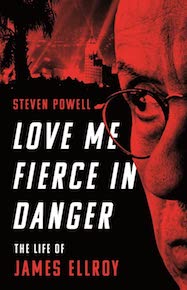 The first time I met James Ellroy, he was standing by himself signing copies of his latest novel in a crowded Murder One. He was rather intimidating figure, tall and spectacularly dressed in full Highland regalia: kilt, sporran and probably with a sgien dubh in his sock (I didn’t check). Now, thanks to Steven Powell’s biography of the self-styled ‘Demon Dog of crime fiction’, Love Me Fierce In Danger [Bloomsbury], I learn that the kilt was often Ellroy’s choice of formal attire, though as far as I can tell he was not of Scottish ancestry, along with plus-fours and his trademark Hawaiian shirts. It was all part of Ellroy’s “schtick” – his determination to get himself noticed and be centre-stage at all costs. The first time I met James Ellroy, he was standing by himself signing copies of his latest novel in a crowded Murder One. He was rather intimidating figure, tall and spectacularly dressed in full Highland regalia: kilt, sporran and probably with a sgien dubh in his sock (I didn’t check). Now, thanks to Steven Powell’s biography of the self-styled ‘Demon Dog of crime fiction’, Love Me Fierce In Danger [Bloomsbury], I learn that the kilt was often Ellroy’s choice of formal attire, though as far as I can tell he was not of Scottish ancestry, along with plus-fours and his trademark Hawaiian shirts. It was all part of Ellroy’s “schtick” – his determination to get himself noticed and be centre-stage at all costs.
His brave biographer does not attempt to hide or excuse Ellroy’s erratic and abusive behaviour as he emerged as a major force in American crime writing, but it is never quite clear when this outrageously talented writer was being outrageous simply as a promotional stunt for his work or if he was genuinely unhinged. Certainly his early life was disturbed, as Ellroy himself has said publicly, at every opportunity. His parents separated and then his mother, whom he fixated on but also disparaged for her drinking and predilection for casual sex, was brutally murdered when he was ten years old. As a youth he became (he claims) a dedicated Nazi, a peeping tom, drank heavily, partook of every drug he could get hold of, indulged in ‘compulsive masturbation,’ went on a housebreaking spree not to rob but to raid women’s underwear drawers (his ‘panty-sniffing’ period), volunteered for the Marine Corps (but within days was faking a nervous breakdown to get out) and held a variety of menial jobs, his most successful being as a golf caddy. Despite all that, he never lost his steely determination to become a writer and the supreme self-confidence that he would become a great one.
Anyone who was around and reading crime fiction in the 1990s would have heard all these stories from Ellroy himself through articles and interviews he gave to promote his legendary ‘L.A. Quartet’ although some of us were already fans of his earlier thrillers such as Blood On The Moon and Silent Terror. Ellroy was abrasive and seemingly compelled to shock an audience wherever he could find one, even when it was someone else’s and Powell’s biography cites an incident in 2010 when he abused and bullied comedienne Laura Kightlinger off the stage of a live performance so he could take over.
What was not so well known, perhaps mercifully, was the extent of Ellroy’s obsessive pursuit of women – a trait he would no doubt class as being a ‘sex pest’. Love Me Fierce In Danger is unflinching in detailing scores of (mostly brief) relationships with females, Ellroy even claiming that in his drinking days he first joined Alcoholics Anonymous simply to meet women.
Somewhere, somehow, within a chaotic, attention-seeking lifestyle where he seemed determined to offend more people than he befriended, Ellroy produced some classic crime novels which turned a jaundiced eye on American history (especially Hollywood) and was never afraid to push his signature scatological style. In most things he was an obsessive and thankfully he was obsessive about his work as a writer, as the increasing scope and scale of his novels shows.
If in his later work his prose became both pared to the bone and overblown (if that’s possible), it is still to be reckoned with and like the author himself, is impossible to ignore.
Fortuitous Find
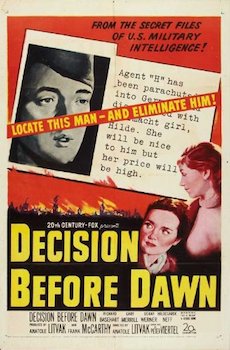 Whilst watching a television channel I never knew I had, I chanced upon a film I did not know existed based on a book I had never heard of. The film, made in 1951, was Decision Before Dawn and it was really rather good tale of how American army intelligence, in early 1945, sent anti-Nazi German prisoners-of-war across the Rhine to spy on and report enemy troop positions. Whilst watching a television channel I never knew I had, I chanced upon a film I did not know existed based on a book I had never heard of. The film, made in 1951, was Decision Before Dawn and it was really rather good tale of how American army intelligence, in early 1945, sent anti-Nazi German prisoners-of-war across the Rhine to spy on and report enemy troop positions.
Whilst the star of the film was clearly meant to be Richard Basehart, the acting honours were easily taken by three Germans: Oskar Werner, Hildegard Neff and Hans Christian Blech, with Werner playing the agent code-named ‘Happy’ who is brave and doing the right thing. Or should that be committing treason? He is, after all, spying on his own country. (And the bomb-damaged Germany of 1945 is brilliantly realised on screen.) Once parachuted back behind ‘enemy lines’, Happy is on his own and can trust no-one and when his escape route back to the Americans is cut off, faces having to swim across an icy – and mined – river Rhine.
So impressed with this film was I that I immediately did a little research and discovered it was based on the book Call It Treason by George Howe and with a few more clicks on the jolly old interweb, I acquired a well-thumbed paperback copy.
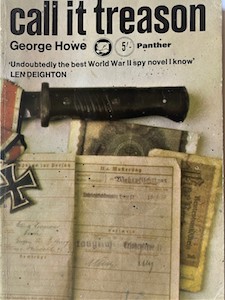 Actually it was not that difficult to find a copy as there seem to have been numerous editions. First published in the USA (and reprinted three times) in 1949, there were then numerous paperback editions 1950-53 and reprints in 1967 and 1980. It was published in the UK in 1950 and my Panther edition of 1966 seems to have been the main (only?) paperback edition, which is odd given its popularity in the States and, it seems, in France. It is very well-written and true-to-life which is not surprising as it turns out to be based on a true story, which prompted me to find out more about the author. Actually it was not that difficult to find a copy as there seem to have been numerous editions. First published in the USA (and reprinted three times) in 1949, there were then numerous paperback editions 1950-53 and reprints in 1967 and 1980. It was published in the UK in 1950 and my Panther edition of 1966 seems to have been the main (only?) paperback edition, which is odd given its popularity in the States and, it seems, in France. It is very well-written and true-to-life which is not surprising as it turns out to be based on a true story, which prompted me to find out more about the author.
George Locke Howe (1898-1977) served in the US Navy during World War I then established himself as an architect in Washington during the New Deal. In the Second World War he served as a civilian member of the OSS attached to the American 7th Army in Algiers, then France and then at the Rhine crossing in 1945. He was involved in the gathering of intelligence using ‘turned’ German nationals in the Mannheim/Heidelburg area and his novel includes personal letters written after the war which suggest that Call It Treason could be ‘faction’ rather than fiction.
Whatever it is, both book and film are worth seeking out.
Royal Appointment
The revered magazine CADS (Crime And Detective Stories) has a (sadly) regular feature titled Death of a Mystery Writer compiled by American obituarian - his word - Marvin Lachman. It lists the recent deaths of crime and thriller writers, editors and publishers along with scriptwriters, directors and actors known for films or television shows with a crime plot.
Being of a certain age I tend to check the feature as soon as my copy of CADS arrives to see if I am listed and the January edition of the magazine did contain a surprise, though not that one. The final entry in the column is a touching report of the death of Her Majesty Queen Elizabeth II, who qualifies, quite rightly, for inclusion due to her appearance in the “Good Evening, Mr Bond” sequence directed by Danny Boyle for the opening ceremony to the 2012 London Olympics.
Write What You Know
After visiting Carcassonne in southern France some years ago, I realised I was disgracefully uninformed about the ‘Cathars’ and the Albigensian Crusade of the 13th century – modern history not being a strong subject of mine. I was able to correct this gap in my medieval knowledge thanks to a splendid popular history (‘popular’ here meaning well-written and a history book you shouldn’t be afraid of), The Perfect Heresy by Stephen O’Shea.
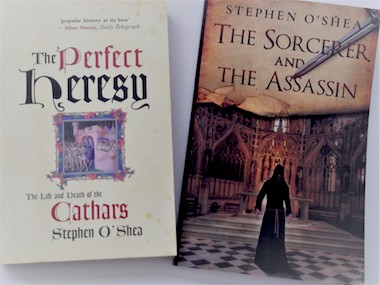
I am now informed by those hyper-active American publishers Brash Books that academic and journalist Stephen O’Shea has written his first novel. Being a Brash Book, The Sorcerer and the Assassin is naturally a crime novel, set in the year 1242 as fanatical Dominican inquisitors roam across France hunting and persecuting suspected heretics but when someone starts knocking off the inquisitors themselves, it could provoke a massacre. I am looking forward to this medieval mystery already confident that the author knows his subject matter supremely well.
As an aside, I highly recommend a visit to Carcassonne, even if the airport there is smaller and less well-organised than a landing-strip in a Gavin Lyall thriller. The city is famous for its spectacular reconstructed architecture (not, as often said, inspired by Walt Disney) and is also home to one of my favourite wine bars, the Barriere Truffes L’Atalier where every glass of wine ordered is offered with three tasting samples and all dishes on the bar menu come with truffles, even the desserts.
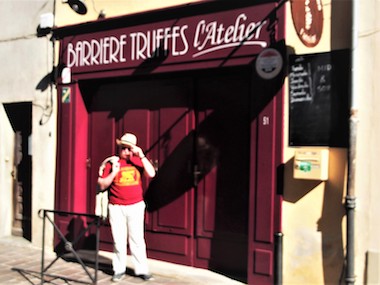
Rumblings Down Under
I hear numerous rumours of good things in crime fiction emerging from Australia, though that in itself should come as no surprise for the genre there has always been lively and many Australian crime writers have truly international reputations. But 2022 does seem to have been a year of high quality for crime novels down under. So says that distinguished reviewer Jeff Popple (and who am I to argue?), who particularly notes the growth of mysteries with a rural setting, a sub-genre rapidly becoming known as bush (or outback) noir. I am also, following Jeff’s recommendations, going to keep an eye out for books from authors new to me and my hit list comprises, so far, of: Dinuka McKenzie, Shelley Burr, Harley Scrivenor and Matthew Spencer.
I hear from that other distinguished commentator on the crime scene, Mark Sanderson of The Times Crime Club, that bestselling Aussie queen of crime Jane Harper has a new novel out in the UK. For legal reasons I have not seen the book and so can tell you nothing about it, although I hear it is very good.
|
|
BOOKS OF THE MONTH
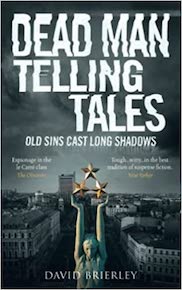
Veteran thriller writer David Brierley has given us some memorable spy novels in the past, from the creation of female rogue agent Cody to a series charting the ‘velvet revolution’ following the collapse of communism and he has specialised in foreign locations including France, Tunisia, Czechoslovakia and Hungary. In Dead Man Telling Tales [Safe House Books], he sets his scene in a post-Soviet Latvia as seemingly respectable British wine merchant Matt Clough travels to Riga having been informed of the death of the father he never knew. The father turns out to be a Latvian with a past, a very shady past, which dogs Clough as he tracks what might be his inheritance for his father appears to have been a spy, though not a particularly loyal one. Fortunately Clough too has a past as a British agent and half-forgotten tradecraft is called into play to keep Clough alive. Written with all the sly cynicism of the spy world, along with some wonderful descriptions of a country coming to terms with a changing present while living with memories of a cruel history, this is Brierley’s first novel in more than twenty years and an elegant reminder of what a fine writer he is.
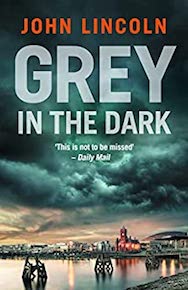
Pounding the mean streets of south Wales seeking to right miscarriages of justice, Gethin Grey leads his team of Last Resort Legals through an underworld, sometimes literally, full of sleazy characters to find the real murderer of Kelly Rowland, a girl loved by too many people for her own good. Grey In The Dark by John Lincoln [No Exit] is the second outing for leading legal eagle Gethin who, like most fictional investigators, comes with a suitcase-on-wheels’ worth of personal baggage: his wife has left him, so he is a single parent and he is also a recovering gambling addict. In addition, he is something of an innocent and occasionally a wimp, but that all adds to the credibility of a character taking on the might of the law in a landscape which ranges from very rough, very tough pubs to posh gated communities of flats built in Cardiff docklands on the site of factories where once a teenage Shirley Bassey worked packing chamber pots!
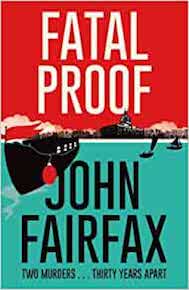
More legal eagles seeking to right miscarriages of justice, including a potentially dangerous situation dating back to The Troubles in Northern Ireland, feature in Fatal Proof by John Fairfax [Abacus]. One of the lawyers, now on the side of the angels, has first-hand experience of being unjustly imprisoned, where he used his spare moments to produce a sort of user-guide to the prison underworld, to which I am indebted for telling me what a ‘Millwall Brick’ is. The nub of the action revolves around some sharp and very clever court room scenes. Rumpole would have raised a glass, possibly two, to this one.
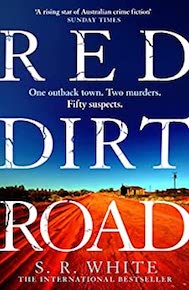
Red Dirt Road [Headline] by S. R. White, a former British policeman now living in Queensland, is an excellent example of Australian outback noir featuring an outstanding female detective in the shape of Dana Russo, definitely a character whose career I will follow with interest. Russo is sent, possibly exiled, to Unamurra, a small town with one pub but fifty-nine registered guns, in the dry and dust-blown outback to take over a moribund murder investigation. Two men have been killed, a month apart, and their bodies hoisted on to frames to be displayed like crucified angels. Detective Russo as an outsider, has to contend with the town’s suspiciously silent residents and the internal power struggles and jealousies within the local police force. But contend she does, even providing a final analysis of the case worthy of Poirot himself.

Having a serial killer on the loose in the Soviet Union, where such an aberration was simply dismissed as impossible, is a theme which has been tackled before in crime fiction and Russia and its satellite states were the natural setting for spy-fiction. Black Wolf [Head of Zeus] by Kathleen Kent attempts to merge the two as an American intelligence fact-finding team is sent to Minsk in Byelorussia in 1990, just as communism is collapsing and capitalism is raising its ugly head as nuclear weapons could be sold off to rogue states (Iran) and a home-grown Mafia is flexing its muscles. Among the Americans is a novice CIA agent with her own special skillset, being a ‘super-recognizer’ who never forgets a face and the Black Wolf of the title is (not a spoiler) the feared head of the local KGB. If a little light on tension and suspense, there are some great bits of spy tradecraft here, not the least being that carrying a packet of Tums (if British, think Rennies though other antacid tablets are available) looks perfectly innocent but they can be used to leave ‘Moscow Rules’ chalk-mark signs when requesting a secret meeting with your cut-out.
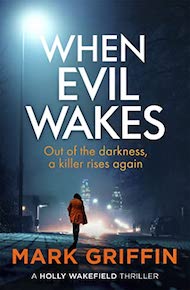
Can anything more be done with the (domestic) serial killer thriller? Mark Griffin certainly has a good go in When Evil Wakes [Piatkus], the fourth outing for criminal psychologist Holly Wakefield, whose parents were murdered by a serial killer known as The Animal. Although pronounced dead – and cremated – it looks like The Animal is back in business with killings tailored to get Holly’s attention. Copycat or miraculous reincarnation? From the chilling opening to the frantic climax, suspend disbelief, climb on this roller coaster and hang onto your hats.
The Eagle Is Landing
Already a bestseller in Sweden and Norway, a new Lisbeth ‘Dragon Tattoo’ Salander thriller, The Girl in the Eagle’s Talons, appears here from MacLehose Press in August.
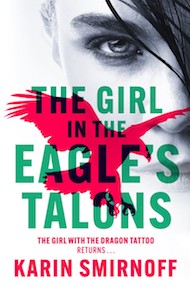
This latest continuation of the late Stieg Larsson’s ‘Millenium’ trilogy is by Swedish novelist Karen Smirnoff and has been translated by Sarah Death. And that’s probably not the first time that Smirnoff and Death have been mentioned in the same sentence.
Mother’s Ruin?
It cannot be coincidence that in March, the month of Mothers’ Day (or Mothering Sunday as it was known up North when I was a lad), publishers should lean towards new books with ‘mother’ in the title. I have already spotted not one, but three, crime novels published next month: The Mother by T.M. Logan [Zaffre], Mother’s Day, a debut for Abigail Burdess [Wildfire], and The Good Mother by Lizzie Fry [Joffre]. I am sure there will be more.
Domestic
There was some disruption to the normal domestic bliss here at Ripster Hall when an advance proof of a book titled Murder By Natural Causes arrived from publisher Muswell Press.
I was confident that the book was a debut crime novel by Helen Erichsen, due to appear in May. The Dowager Lady Ripster, however, snatched the volume from the hands of a startled postman declaring that it was a non-fiction, self-help instruction manual which she had ordered personally.
Pip! Pip!
The Ripster
|